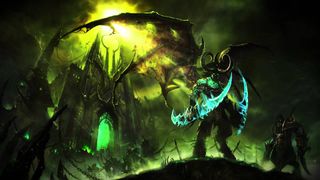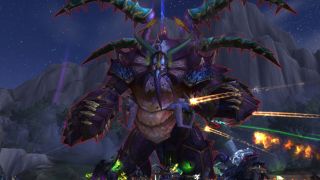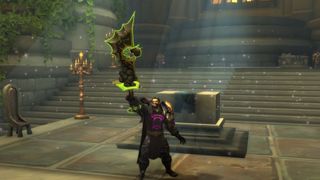Farewell to Legion, World of Warcraft's best expansion in a decade
As Battle for Azeroth inches closer, we look back at all the ups and downs of Legion.

Yesterday Blizzard released patch 8.0 for World of Warcraft, effectively signaling the beginning of the next expansion, Battle for Azeroth. It's an exciting update full of changes both big and small, but 8.0 also heralds the end of Legion, the best expansion since 2008's Wrath of the Lich King. Now that it's over, I can't help but feel sad. It's been a great two years of World of Warcraft's now 13-year-old life. Not many games this old get better with age, but Legion is bound to be an expansion people fondly remember for years to come.
And it's easy to see why. After what basically amounted to a mid-life crisis with Catacylsm and Warlords of Draenor, World of Warcraft has settled into confident maturity—a bold vision that pays homage to the past while not being chained to it. Legion made World of Warcraft more accessible than ever before while also nailing a cadence of updates and dynamic content that made sure I always had a reason to log in. After years of worrying if World of Warcraft's best years are behind it, Legion is a strong argument otherwise.
To the Broken Isles
Legion, Warcraft's sixth expansion, launched almost two years ago on August 30, 2016. When I first reviewed it back then, I said it bore "a terrible weight" by having to make up for the flop that was Warlords of Draenor. While Warlords of Draenor started off promising, its core features isolated players into singleplayer instances of the world and meaningful updates were too few and far between. Soon after, Blizzard revealed that World of Warcraft had shed over 3 million subscribers since Warlords' launch. There just wasn't much reason to play. While World of Warcraft was still easily the most popular MMO with over 6 million subscribers, it wasn't very promising news for the future of the game. And Legion would have to be the expansion that turned these ill omens around.
When Blizzard first announced Legion at Gamescom 2015, fans were concerned that it might be a rushed expansion to shore up the ongoing discontent with Warlords of Draenor. But when Blizzard did an in-depth reveal a few months later at Blizzcon, it was already clear that Legion wasn't repeating Warcraft's past mistakes. Instead, Blizzard wanted to give players everything they been asking for since The Burning Crusade launched in 2006.

Gone were the singleplayer Garrisons, for example, that confined players to their own little base whenever they weren't out questing. Instead, Legion would introduce class-specific Order Halls where everyone of that same class would hang out to pick up new story quests, assign duties to NPC followers, and power up new artifact weapons. And Demon Hunters finally became a playable class—one of the best that Blizzard has ever designed. Not only are they great in combat (I particularly love how indomitable the tanky Vengeance specialization feels), but their ability to fly and overall mobility made World of Warcraft feel kinetic in a way it never had before. I mained a Demon Hunter throughout the entirety of Legion and loved it.
I mained a Demon Hunter throughout the entirety of Legion and loved it.
When I first played Legion, I found one of World of Warcraft's most exquisitely detailed and designed zones to date. The Broken Isles were a Greatest Hits of World of Warcraft lore, with each zone pulling inspiration from a beloved corner of Azeroth. Val'Sharah was a rich woodland slowly succumbing to a festering rot, while Azsuna was a melancholy elven ruin. Each of the five zones were so distinct it felt a bit silly going from one to the next but they also exemplified how good Blizzard is at world building. One subtle yet major improvement was with level-scaling, which has now been applied to all of the old zones too. In Legion, each of the four leveling zones could be tackled in whatever order you wanted and monsters would always scale to your level to keep things challenging.
Legion also improved and iterated on Warlords of Draenor's already great quest design. Treasures, elite monsters, and easter eggs were scattered everywhere, encouraging me to take countless detours to my next objective. And the quests themselves varied greatly and told interesting stories that helped deepen my understanding of the world and its inhabitants. I particularly loved Suramar, the endgame zone restricted for characters at level 110. This elven city was a huge step forward in how Blizzard designed urban areas. Each district was buzzing with activity and interesting things to see and do. The overarching story of the exiled Nightborne starting a revolution in Suramar that was told over the course of two updates was fun despite, at times, feeling like a grind.
The biggest gaming news, reviews and hardware deals
Keep up to date with the most important stories and the best deals, as picked by the PC Gamer team.
While I'd still like to see Battle for Azeroth improve on this, Legion felt more social thanks to public Order Halls and new World Quests. Once players reached the level cap of 110, World Quests would dynamically spawn all over the Broken Isles that offered all kinds of loot. It encouraged players to get out there and exist in the world instead of hiding in Dalaran waiting for to get into pre-matched dungeons and raids. It meant the world itself was constantly full of players to team up with and (if the mood struck me) gank.
Pace yourselves
Mythic+ made dungeons an endgame activity instead of a stepping stone, and it was challenging as hell.
If there are two major features that ensure Legion will be fondly remembered, it is undoubtedly Mythic+ dungeons and the pace of updates. The first was a much-needed reimagining of how dungeons fit into the growing list of activities a player has once they reach level cap. In previous expansions, dungeons were often treated like a stepping stone to the ultimate endgame: raiding. But the problem was that, once you ran them enough times to get the gear you needed, there were few reasons to go back.
Legion fixed this in a big way. Taking a nod from Diablo 3's Rifts, Mythic+ was a new, flexible difficulty mode that rewarded gear that was as good as anything you could find in raids. Each week, players would get a Mythic Keystone that unlocked a specific Mythic+ version of a dungeon with enemies that had increased health and damage over their regular Mythic versions. If you beat the dungeon, you got more powerful loot and your keystone leveled up to a more difficult tier of Mythic+ and set you off toward another dungeon.
But the real challenge came from the affixes that would slowly be layered on as your Mythic Keystone reached higher levels. Enemies might ignore tanks and go for healers, empower their allies when they die, or spawn explosive orbs that need to be destroyed. More sinister affixes would punish healers for going overboard or send shockwaves out from players that damage and interrupt their allies.
Mythic+ made dungeons an endgame activity instead of a stepping stone, and it was challenging as hell. It pushed teams to their limits and rewarded with amazing gear but dispensed with the sometimes unnecessary and unaccessible requirements of hardcore raiding. More importantly, it made dungeons fun to run each week rather than another grind. It's no surprise Mythic+ will stay a central pillar in Battle for Azeroth's dungeons.

But the best thing about Legion that everyone can appreciate is how aggressively Blizzard released major updates. To put it in perspective, Warlords of Draenor only had two major updates while Legion had a whopping five.
Update 7.1 came only two months after Legion's launch and introduced Return to Karazhan, a fan-favorite raid converted into a mega-dungeon that could take hours to fully complete the first few times. Two and a half months later Patch 7.1.5 rolled out a new raid, The Nighthold, while also bringing a new Timewalking Dungeon event (where players can jump into dungeons from older expansions for rewards) and the hectic Brawler's Guild boss-rush mode. Another two months saw the release of 7.2, which added a mini-zone, new dungeon and raid, and dynamic demon invasions across the Broken Isles. And five months after that, Legion got its biggest update when Blizzard added three mini-zones on the never before seen planet of Argus, a new raid and dungeon, two new factions, and smaller features like Invasion Points.
There was always something to do in Legion and Blizzard really outdid itself in 7.3 when players became intergalactic travelers and explored Argus, the headquarters of The Burning Legion. It was a dramatic climax to an expansion full of dramatic climaxes. It was only earlier this year that things started to slow down a bit as Blizzard shifted focus to developing Battle for Azeroth. The only massively annoying part of Legion was the way 7.2 time-gated much of its story to drip feed players for 11 weeks until the new raid opened up. But, in hindsight, it's hard to stay bitter considering how great Legion's other post-launch updates were. It finally felt like, after the drought of Warlords of Draenor, Blizzard hit a stride that kept everyone happy.
As a matter of Artifact
Not everything about Legion was sunshine and demon-slaying. While Blizzard nailed how players got new loot, Legion dropped the ball on what that new loot was. Near the beginning the expansion, each class specialization was given a unique Artifact Weapon—a powerful instrument of war like Thrall's fabled Doomhammer. The message was clear: Players were going to wield the most powerful weapons in the known world against The Burning Legion.
At first, Artifact Weapons were great. Unlike normal gear, they had inherent traits that were unlocked and leveled up by way of Artifact Power. At first, the choice of what traits to level up made a significant effect, but later on Artifact Weapons felt like a linear grind for marginal improvement. They just weren't exciting anymore. Even worse, Artifact Weapons made leveling alternate characters a real pain early in Legion. Players had to wait real time on annoying 'research levels' in order to get their new Artifact Weapons up to par with their other characters', a process that became so awful Blizzard just removed it entirely in a later update. In hindsight, Artifact Weapons were fun to wield but just weren't all that interesting to level up.
But even Artifact Weapons pale in comparison to Legion's most egregious problem: Legendary gear. In previous expansions, Legendary items were awarded for herculean feats like completing epic questlines or beating the hardest raids multiple times. It was a sign of your status as a top-tier player, and Legion threw all of that away for a system that favored RNG above all else.

Throughout the length of the expansion, Blizzard tried to update Legendaries and make them less terrible but the damage was done.
Like Diablo 3, Legendaries in Legion could be obtained from anywhere and anything. You could sneeze on a sickly antelope and a Legendary item could pop out. It wasn't rewarding at all. What's worse, these Legendaries had a dramatic effect on your performance in combat. But because all of it was RNG, it was completely random who had the best Legendaries and who had none at all—and that made players furious. Throughout the length of the expansion, Blizzard tried to update Legendaries and make them less terrible but the damage was done.
An equally annoying system was Titan-Forging, which would sometimes take dropped equipment and randomly make it stronger for no reason at all. Like Legendaries, it was complete RNG that gave players exorbitantly powerful gear without requiring anything extra of them. It was meant to be a nice little bonus but those without Titan-Forged gear felt left out. It was these random elements of Legion that really made loot feel like a crapshoot. Players have embraced that monsters might not always drop the gear they want, but it was supremely frustrating to have someone else get a significantly stronger piece of gear for no real reason other than luck. But compared to where Legion succeeded, these frustrations are a small (but very noticeable) stain.
When I first reviewed Legion and gave it a 90 out of 100, I was terrified that, like Warlords of Draenor, it would make a great first impression but drop the ball months down the road. Instead, Legion improved significantly with each new update by adding a staggering amount of quests to do and areas to explore. At the same time, smart innovations like Mythic+ pushed this 14-year-old MMO ahead of its competitors by refreshing a stale formula and making it an exciting and worthwhile investment.
Though it stumbled at times, Legion was everything I wanted from World of Warcraft: An immense world to explore, tough-as-nails group content, and a constant stream of new things to do each week. Now that it's over, I can safely say that Legion is the best two years I've had playing World of Warcraft since it first launched in 2004. Battle for Azeroth is only a month away from launch, but Blizzard has their work cut out for them if they hope to top Legion.
With over 7 years of experience with in-depth feature reporting, Steven's mission is to chronicle the fascinating ways that games intersect our lives. Whether it's colossal in-game wars in an MMO, or long-haul truckers who turn to games to protect them from the loneliness of the open road, Steven tries to unearth PC gaming's greatest untold stories. His love of PC gaming started extremely early. Without money to spend, he spent an entire day watching the progress bar on a 25mb download of the Heroes of Might and Magic 2 demo that he then played for at least a hundred hours. It was a good demo.
Most Popular


